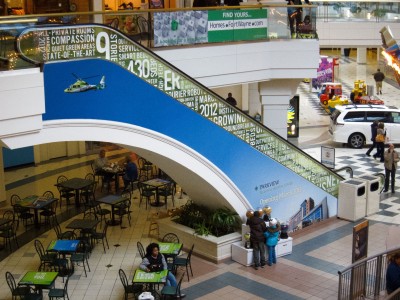Print media advancements
A proliferation of new print media developed specifically to meet the needs of the POP display market has been equally fundamental as new printers in expanding opportunities for sign shops. This is because the nature of POP displays varies from that of traditional signs.
A POP campaign typically lasts anywhere from 30 to 90 days, which is relatively short in sign-industry terms. So, the long-lasting, durable media used for other applications may not be necessary to achieve the desired effect.

With lower prices and easier application, window films have become more popular for large-scale but short-term displays.
Instead, retailers need materials that can be installed easily by an untrained sales associate, will look great and stand up to wear and tear throughout a short-term campaign and then can just as easily be removed. They also need a reasonable price point.
Wall graphic films are one example of print media that have become more popular in the POP market, particularly in ‘big box’ stores, where they are used for poster-size applications. These films tend to be easy to use at the individual store level, as they do not require professional installation, so they are a relatively affordable way for retailers to display promotional messages.
It is important for these films to use a repositionable adhesive, so untrained staff can make adjustments to fix any mistakes before the graphics take a firm hold on the wall surface, and they must also be easily and cleanly removable at the end of a campaign.
Floor and window graphics are also becoming more popular thanks to easier-to-apply films. And as these products’ costs have been dropping, they are reaching price points that are comfortable for retailers who only need short-term displays.
Some floor graphic films can even be installed on rough outdoor concrete surfaces for up to three months, allowing graphics to garner new attention in unconventional locations, both as part of a multimedia POP campaign and for longer-term branding.
Another way to add durability where needed is to protect printed graphics with overlaminates. That said, lamination is also increasingly being used to enhance POP displays visually. Textured overlaminates, for example, can add a wood-grain, brushed-metal, carbon-fibre or leather finish. They are a simple way to achieve a high-end appearance without paying high-end material prices.
Overlaminates can also be added to substrates to protect and enhance displays. They are a simple way to achieve more uniform colour consistency, for example, where it might otherwise be difficult. And on certain surfaces, a gloss or matte finish can improve a message’s readability.
A repositionable adhesive is very important when applying wall films, especially to pillars and other unusual surfaces, so any mistakes can be fixed before the graphics are firmly in place.
Another trend that is seeing significant interest in the POP display market is the increasing range of environmentally sustainable materials, including recycled and recyclable films. Since promotional retail graphics are typically only used for a short term before they are discarded, there has traditionally been a substantial amount of waste in the industry. Chlorine-free and phthalate-free graphic materials are allowing sign shops and retailers to minimize their environmental impact.
Emerging trends
While recent progress in both printing and material technologies has positioned the POP display market for growth, there are other emerging trends that could also help shape the industry in the coming years.
Direct-to-substrate printing
Some of today’s wide-format presses can now print directly onto a wide range of substrates, from wood to metal to textiles, rather than onto vinyls or other materials that then need to be attached to a display. This capability not only saves time and expense, but can also be beneficial in terms of environmental sustainability, as the aforementioned latex inks can be printed directly onto graphic boards that can be fully recycled at the end of a campaign.





